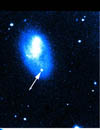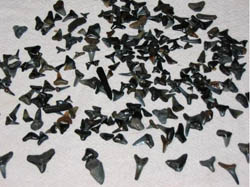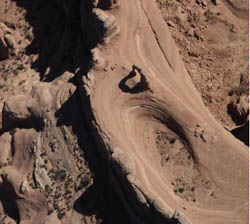Profile: Dr. Duilia De Mello
You don't have to have a telescope as a child to develop an interest in astronomy. Dr. Duilia de Mello grew up without one in Brazil, but she was inspired by the moon just the same.
Biography
Though born in Sao Paulo, Duilia grew up in Rio de Janeiro, one of the most beautiful cities in the world -- in her opinion and that of many others. She was always very curious and wanted to know more about the Universe. Since they weren't teaching enough about it in school for her taste, she decided to become an astronomer to learn everything there was to learn. Unlike in the U.S., where men greatly outnumber women in the astronomy field, they are equally represented in Brazil, so Duilia was not at all intimidated.
She chose to focus on extragalactic astronomy so she could study extremely distant objects. Her undergraduate degree is from the Federal University in Rio de Janeiro (site written in Portuguese), and she holds two master's degrees, one from the Brazilian National Institute for Space Research in Radio Astronomy and another from the University of Alabama in Astronomy.
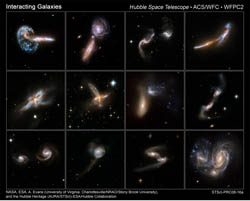
A collection of views of colliding galaxies from the Hubble Space Telescope -- Credit: NASA, ESA, A. Evans (University of Virginia, Charlottesville/NRAO/Stony Brook University), and the Hubble Heritage Team (STScI/AURA)-ESA/Hubble Collaboration
While working on her master's degree, Duilia read about interacting galaxies (image, right, from Hubble Space Telescope) and met a few astronomers working in the specialty. She became quite interested in understanding how galaxies collide and transform themselves during the interaction, and that lead to her PhD thesis topic. She earned her doctorate from the University of Sao Paulo.
Her next job was as a post-doctoral research associate at Cerro Tololo Observatory in Chile, followed by another post-doc position at the Space Telescope Science Institute (STScI) in Baltimore. From there, Duilia went to Gothenburg, Sweden, to work as an Assistant Professor at Chalmers University.
Duilia had met some astronomers from the nearby NASA Goddard Space Flight Center (GSFC) when she was working at STScI, so she contacted them looking for a job. Dr. Jonathan Gardner decided to hire her.
Current Work
Duilia works at GSFC as part of the research faculty for Catholic University of America (CUA), though she also teaches at CUA. She continues to work with interacting galaxies near -- at least in galactic terms -- and far, analyzing the effects of the interaction on them. Her investigations include, for example, studying whether colliding galaxies form stars more effectively than isolated galaxies.
She is particularly interested in establishing how galaxies become like our own galaxy. The Milky Way is a spiral galaxy with modest star formation, containing both old and young stars. What we don't know is when it acquired its shape and how that is related to the age of the stellar population.
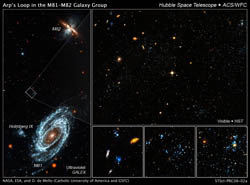
Location of the blue blobs in interacting galaxies M81 and M82 Credit: NASA, ESA, and D. de Mello (Catholic University of America/GSFC)
Duilia is also trying to understand how stars are born outside galaxies. Stars are known to form in galaxies inside very compact and dense gas clouds. It was believed that those conditions are only found inside galaxies. But Duilia has recently found several stellar clusters formed outside galaxies in sparse regions of space. Her research team nicknamed them "blue blobs" because that's what they look like in images from the ultraviolet space telescope that detected them, NASA's Galaxy Evolution Explorer (GALEX). As they gain a better understanding of the blobs, they will most likely acquire a more dignified name.
The team is trying to calculate the masses and ages of the blobs to learn whether they are young objects formed outside galaxies or objects that were ejected by galaxies during collisions. There is an article on some of this amazing recent work that was presented at the January 2008 American Astronomy Society meeting, and there are related videos and images linked from the article (one of them is above).
Typical Workday
For her research at GSFC, Duilia has two graduate students working with her right now, and she supervises their work. She also travels frequently -- to conferences, for telescope observations, and to collaborate with other scientists in the US and abroad. Like other astronomers, Duilia spends a lot of time in front of the computer. She analyzes images, writes articles, and writes proposals for opportunities to use the observatories and satellites to gather data for research.
What's Best About Working in Science?
Duilia enjoys learning new things and having an environment that allows her to develop and pursue new ideas. She feels it is a privilege to be able to see the Universe as a whole and understand how small we are in comparison.
If you read Duilia's website, you'll find a wonderful page on why she is an astronomer. You can read about her exhilarating experience of actually discovering supernova SN1997D. Not surprisingly, this was also her choice for her image.
Other Interests
Duilia never has a dull moment.
As a child, she collected all kinds of things: stamps, key chains, postcards, pencils, etc., but she stopped when she went out into the world on her own. Only recently did Duilia realize how much she missed collecting -- and at about the same time she fell in love with fossils. Her collection contains only fossils more than a million years old, choosing that cutoff because stars can be as young as one million years. Duilia can say she collects fossils that are older than stars! She has more than a thousand pieces, most of them discovered on her own.
Duilia also blogs 2-3 hours a week for a Brazilian popular science magazine called Superinteressante, sharing the latest news in astronomy and space science. She is known there as the Woman of the Stars (Mulher das Estrelas), and her blog receives many comments. She even has a fan club. The Superinteressante magazine blog and her own blog are both written in her native language of Portuguese.
Aerial photography is another of Duilia's interests. Much to her advantage, her husband is a single-engine airplane pilot. Duilia travels with him as the navigator and photographer. She notes that the Earth from above is a very different-looking planet! You can see some of her photos on her website. Shown here is the Delicate Arch in Utah, one of her favorites.
Questions and Answers
If time travel were possible, when and where would you visit, and why?
I would go to the future. I would love to know what the newest discoveries are and whether we have been able to travel to other planets and solar systems.
What is the most unusual question or comment you have ever gotten?
One interesting question that I have gotten is "How can you sleep at night knowing so much?" My answer to that is that I can only sleep at night because I know I will wake up the next day and learn some more.
If you weren't a scientist, what would you be?
I could be a mathematician. I have always loved math and solving problems. I could also be a paleontologist. I would be on expeditions searching for fossils that are as old as stars.
If you could invite three people from throughout history to your house for dinner, who would you invite and why?
I would invite the Nobel Prize winner Marie Curie. I read her biography and was really fascinated by her dedication to science. I would also invite Neil Armstrong and Buzz Aldrin, the first two men who walked on the Moon.
Who was your favorite teacher in school? What was this teacher like and how did he/she influence your life?
I had a couple of teachers who influenced me a lot. One of them was a science teacher who showed great love for science and motivated us to be curious. Another one was a math teacher. He was so energetic and made math a lot of fun. I also had a wonderful history teacher who motivated me to study astronomy since that was what I liked to do.
What do you think is the most important technological advance that has occurred in your lifetime?
I think the fact that we have satellites in orbit is one of the most important steps in technology.
Do you have a family? A pet?
I am happily married to a Swedish astronomer, Tommy Wiklind. We love to travel and have been all over the world together. We don't have any pets. I had way too many pets when I was a kid -- parrots, fish, ducks, and dogs. Two of my favorite dogs were Mickey (a guard dog) and Pedrita (an indoor dog).
What is the one big dream you have, or the one thing that you would like to accomplish during your lifetime?
I would like to have more time to write and publish books. I am currently working on a book for teens that is part autobiography, but mostly it is meant to be inspirational and educational. The text of my book (in Portuguese) is also on my blog site. Hopefully that will be published in Brazil soon.
Publication Date: June, 2008




